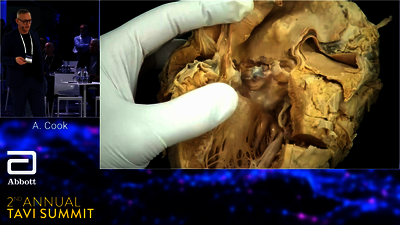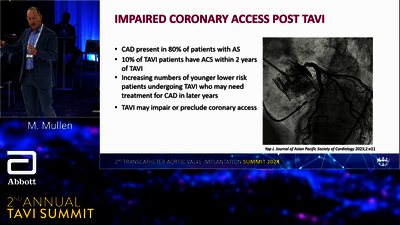Aortic Stenosis (AS) is the most common primary valve disease leading to surgery or catheter intervention in Europe and North America.1 It is present in approximately 2% of the general population with a rising prevalence in the elderly (up to 6% in patients above 85 years old).2-4
Symptomatic AS has significant effects on a patient’s health and quality of life5,6 and many will have cardiovascular and other comorbidities, for example, other valvular diseases, diabetes mellitus, hypertension and peripheral vascular disease.7-11

The 2021 European Society of Cardiology/European Association of Cardiothoracic Surgery (ESC/EACTS) Guidelines for the management of Valvular Heart Disease (VHD) stipulate that heart valve centers should promote timely referral of patients with VHD.18 Symptomatic severe AS has a dismal prognosis and guidelines strongly recommend early intervention in all patients.1,18
Treatment options for aortic stenosis:
MEDICAL MANAGEMENT
Medical treatment options for symptomatic patients with severe AS are limited. Medical treatment may be helpful in ameliorating symptoms in the short term but does not change the poor prognosis and natural history of severe AS.19
VALVE REPAIR
Surgical aortic valve repair in the setting of AS is currently only applied on a limited scale.20 Repair is most suitable for treatment of aortic regurgitation, rather than for stenosis, except for younger patients with a uni- or bicuspid valve.21,22
VALVE REPLACEMENT
Valve replacement is the only definitive treatment for severe, symptomatic AS. Surgical Aortic Valve Replacement (SAVR) and transcatheter aortic valve implantation (TAVI) are both guideline-recommended treatments for severe, symptomatic AS:
- SAVR: Younger patients who are low risk for surgery (<75 years and STS-PROM*/EuroSCORE II <4%), or in patients who are operable and unsuitable for transfemoral TAVI.18
- TAVI: Older patients (≥75 years), or in those who are high risk (STS-PROM*/EuroSCORE IIf >8%) or unsuitable for surgery.18
- SAVR or TAVI are recommended for remaining patients according to individual clinical, anatomical, and procedural characteristics.18
WATCHFUL WAITING
Watchful waiting may be a safe strategy for asymptomatic patients without risk factors predicting symptom development.1
It is recommended that patients with valvular heart disease should be managed through a multidisciplinary heart team comprising clinical and interventional cardiologists, cardiac surgeons, imaging specialists with expertise in interventional imaging, cardiovascular anaesthesiologists, and other specialists if necessary (e.g. heart failure specialists or electrophysiologists).18
The 2021 ESC/EACTS Guidelines for the management of VHD stipulate that the choice between surgical and transcatheter intervention must be based upon careful evaluation of clinical, anatomical, and procedural factors by the heart team, weighing the risks and benefits of each approach for an individual patient. The heart team recommendation should be discussed with the patient who can then make an informed treatment choice.18
*STS-PROM=Society of Thoracic Surgeons predicted risk of mortality
Connext
Live
TV
HUB
- Falk V, Baumgartner H, Bax JJ et al. 2017 ESC/EACTS Guidelines for the management of valvular heart disease. Eur J Cardiothorac Surg. 2017;52(4):616–664. doi.org/10.1093/ejcts/ezx324.
- Lindroos M, Kupari M, Heikkilä J et al. Prevalence of aortic valve abnormalities in the elderly: an echocardiographic study of a random population sample. J Am Coll Cardiol. 1993;21(5):1220–1225. doi.org/10.1016/0735-1097(93)90249-Z.
- Osnabrugge RLJ, Mylotte D, Head SJ et al. Aortic stenosis in the elderly: disease prevalence and number of candidates for transcatheter aortic valve replacement: a meta-analysis and modeling study. J Am Coll Cardiol. 2013;62(11):1002–1012. doi.org/10.1016/j.jacc.2013.05.015.
- d'Arcy JL, Coffey S, Loudon MA et al. Large-scale community echocardiographic screening reveals a major burden of undiagnosed valvular heart disease in older people: the OxVALVE Population Cohort Study. Eur Heart J. 2016;37(47):3515–3522. doi.org/10.1093/eurheartj/ehw229.
- van Geldrop MWA, Heuvelman HJ, Kappetein AP et al. Quality of life among patients with severe aortic stenosis. Neth Heart J. 2013;21(1):21–27. doi.org/10.1007/s12471-012-0364-9.
- Oterhals K, Haaverstad R, Nordrehaug JE et al. Self-reported health status, treatment decision and survival in asymptomatic and symptomatic patients with aortic stenosis in a Western Norway population undergoing conservative treatment: a cross-sectional study with 18 months follow-up. BMJ Open. 2017;7(8):e016489. dx.doi.org/10.1136/bmjopen-2017-016489.
- Iung B, Baron G, Tornos P et al. Valvular heart disease in the community: a European experience. Curr Probl Cardiol. 2007;32(11):609–661. doi.org/10.1016/j.cpcardiol.2007.07.002.
- Faggiano P, Frattini S, Zilioli V et al. Prevalence of comorbidities and associated cardiac diseases in patients with valve aortic stenosis. Potential implications for the decision-making process. Int J Cardiol. 2012;159(2):94–99. doi.org/10.1016/j.ijcard.2011.02.026.
- Maisano F, Worthley S, Rodés-Cabau J et al. Early commercial experience from transcatheter aortic valve implantation using the Portico™ bioprosthetic valve: 30-day outcomes in the multicentre PORTICO-1 study. EuroIntervention. 2018;14(8):886–893. doi.org/10.4244/EIJ-D-18-00343.
- Reardon MJ, Van Mieghem NM, Popma JJ et al. Surgical or transcatheter aortic-valve replacement in intermediate-risk patients. N Engl J Med. 2017;376(14):1321–1331. doi.org/10.1056/NEJMoa1700456.
- Leon MB, Smith CR, Mack MJ et al. Transcatheter or surgical aortic-valve replacement in intermediate-risk patients. N Engl J Med. 2016;374(17):1609–1620. doi.org/10.1056/NEJMoa1514616.
- Olszowska M. Pathogenesis and pathophysiology of aortic valve stenosis in adults. Pol Arch Med Wewn. 2011;121(11):409–413. www.mp.pl/paim/issue/article/1103/.
- Czarny MJ et al. Diagnosis and management of valvular aortic stenosis. Clin Med Insights Cardiol. 2014;8(Suppl 1):15–24. doi.org/10.4137/CMC.S15716.
- Nishimura RA, Otto CM, Bonow RO et al. 2014 AHA/ACC guideline for the management of patients with valvular heart disease: a report of the American College of Cardiology/American Heart Association Task Force on Practice Guidelines. J Thorac Cardiovasc Surg. 2014;148(1):e1–e132. doi.org/10.1016/j.jtcvs.2014.05.014.
- Zakkar M, Bryan AJ, Angelini GD. Aortic stenosis: diagnosis and management. BMJ. 2016;355:i5425. doi.org/10.1136/bmj.i5425.
- Indolfi C, Bartorelli AL, Berti S et al. Updated clinical indications for transcatheter aortic valve implantation in patients with severe aortic stenosis: expert opinion of the Italian Society of Cardiology and GISE. J Cardiovasc Med (Hagerstown). 2018;19(5):197–210. doi.org/10.2459/JCM.0000000000000636.
- Grimard BH, Safford RE, Burns EL. Aortic stenosis: diagnosis and treatment. Am Fam Physician. 2016;93(5):371–378. www.aafp.org/pubs/afp/issues/2016/0301/p371.html.
- Vahanian A, Beyersdorf F, Praz F et al. 2021 ESC/EACTS Guidelines for the management of valvular heart disease. Eur Heart J. 2022;43(7):561–632. doi.org/10.1093/eurheartj/ehab395
- Kanwar A, Thaden JJ, Nkomo VT. Management of patients with aortic valve stenosis. Mayo Clin Proc. 2018;93(4):488-508. doi.org/10.1016/j.mayocp.2018.01.020.
- “Aortic Valve Stenosis - Diagnosis and Treatment - Mayo Clinic.” Aortic Valve Stenosis - Diagnosis and Treatment - Mayo Clinic, 18 August 2022, www.mayoclinic.org/diseases-conditions/aortic-stenosis/diagnosis-treatment/drc-20353145 (accessed May 2023).
- Ram E, Sternik L, Lipey A, et al. Clinical and echocardiographic outcomes after aortic valve repair in patients with bicuspid or unicuspid aortic valve. Isr Med Assoc J. 2018;20(7):423–428. www.ima.org.il/FilesUploadPublic/IMAJ/0/294/147319.pdf.
- Martín M, Lorca R, Rozado J, et al. Bicuspid aortic valve syndrome: a multidisciplinary approach for a complex entity. J Thoracic Dis. 2017;9(Suppl 6):S454–S464. doi.org/10.21037/jtd.2017.05.11.
- Généreux P, Stone GW, O'Gara PT et al. Natural history, diagnostic approaches, and therapeutic strategies for patients with asymptomatic severe aortic stenosis. J Am Coll Cardiol. 2016;67(19):2263–2288. doi.org/10.1016/j.jacc.2016.02.057.
- Lund O. Preoperative risk evaluation and stratification of long-term survival after valve replacement for aortic stenosis. Reasons for earlier operative intervention. Circulation. 1990;82(1):124–139. doi.org/10.1161/01.CIR.82.1.124.
- Nashef SA, Roques F, Sharples LD et al. EuroSCORE II. Eur J Cardiothorac Surg. 2012;41(4):734–744;discussion 744–745. doi.org/10.1093/ejcts/ezs043.
- Roques F, Michel P, Goldstone AR et al. The logistic EuroSCORE. Eur Heart J. 2003;24(9):881–882. doi.org/10.1016/S0195-668X(02)00799-6.
- Roques F, Nashef SA, Michel P et al. Risk factors and outcome in European cardiac surgery: analysis of the EuroSCORE multinational database of 19030 patients. Eur J Cardiothorac Surg. 1999;15(6):816–822;discussion 822–823. doi.org/10.1016/S1010-7940(99)00106-2.
- Thourani VH, Suri RM, Gunter RL et al. Contemporary real-world outcomes of surgical aortic valve replacement in 141,905 low-risk, intermediate-risk, and high-risk patients. Ann Thorac Surg. 2015;99(1):55–61. doi.org/10.1016/j.athoracsur.2014.06.050.
- Brown JM, O’Brien SM, Wu C et al. Isolated aortic valve replacement in North America comprising 108,687 patients in 10 years: changes in risks, valve types, and outcomes in the Society of Thoracic Surgeons National Database. J Thorac Cardiovasc Surg. 2009;137(1):82–90. doi.org/10.1016/j.jtcvs.2008.08.015.
- Culler SD, Cohen DJ, Brown PP et al. Trends in aortic valve replacement procedures between 2009 and 2015: has transcatheter aortic valve replacement made a difference? Ann Thorac Surg. 2018;105(4):1137–1143. doi.org/10.1016/j.athoracsur.2017.10.057.
- O'Brien SM, Shahian DM, Filardo G et al. The Society of Thoracic Surgeons 2008 cardiac surgery risk models: part 2--isolated valve surgery. Ann Thorac Surg. 2009; 88(1 Suppl):S23–42. doi.org/10.1016/j.athoracsur.2009.05.056.
- Durko AP, Osnabrugge RL, Kappetein AP. Long-term outlook for transcatheter aortic valve replacement. Trends Cardiovasc Med. 2018;28(3):174–183. doi.org/10.1016/j.tcm.2017.08.004.
- McDonagh TA, Metra M, Adamo M et al. 2021 ESC Guidelines for the diagnosis and treatment of acute and chronic heart failure. Eur Heart J. 2021;42(36):3599–3726. doi.org/10.1093/eurheartj/ehab368.
- Filardo G, Hamilton C, Hamman B et al. New-onset postoperative atrial fibrillation and long-term survival after aortic valve replacement surgery. Ann Thorac Surg. 2010;90(2):474–479. doi.org/10.1016/j.athoracsur.2010.02.081.















